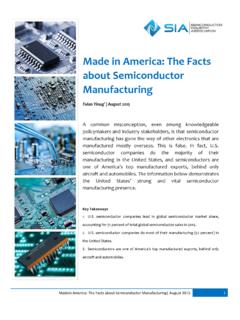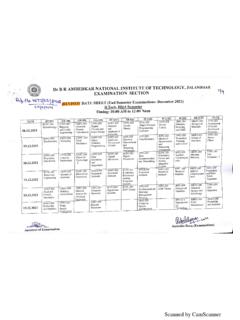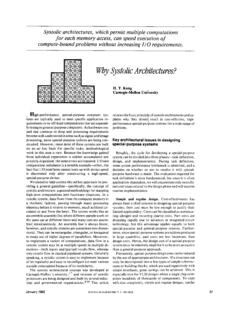Transcription of Government Incentives and US Competitiveness in ...
1 Government Incentives and US Competitiveness in Semiconductor ManufacturingSeptember 2020By Antonio Varas, Raj Varadarajan, Jimmy Goodrich, and Falan Yinug Boston Consulting Group partners with leaders in business and society to tackle their most important challenges and capture their greatest opportunities. BCG was the pioneer in business strategy when it was founded in 1963. Today, we help clients with total transformation inspiring complex change, enabling organizations to grow, building competitive advantage, and driving bottom-line succeed, organizations must blend digital and human capabilities. Our diverse, global teams bring deep industry and functional expertise and a range of perspectives to spark change. BCG delivers solutions through leading-edge management consulting along with technology and design, corporate and digital ventures and business purpose. We work in a uniquely collaborative model across the firm and throughout all levels of the client organization, generating results that allow our clients to Semiconductor Industry Association (SIA) is the voice of the semiconductor industry in the US, one of America s top export industries and a key driver of America s economic strength, national security, and global Competitiveness .
2 The semiconductor industry directly employs nearly a quarter of a million workers in the US, and US semiconductor company sales totaled $193 billion in 2019. SIA members account for nearly 95 percent of all US semiconductor industry sales. Through this coalition, SIA seeks to strengthen leadership of semiconductor manufacturing, design, and research by working with policymakers and key industry stakeholders to encourage policies that fuel innovation, propel business, and drive international competition. Contents01 Executive Summary 03 Introduction05 Current US Position in Semiconductor Manufacturing11 Why It Matters14 Understanding US Competitive-ness vs. Global Alternative Locations 21 The Opportunity to Change the Trajectory in the Next Decade25 Turning the Tide for US Semiconductor Manufacturing 1 Government Incentives AND US Competitiveness IN SEMICONDUCTOR MANUFACTURINGE xecutive SummaryThe semiconductor industry is critical to economic Competitiveness and national security in an era of digital transformation, artificial intelligence, and 5G communications.
3 The US semiconductor industry has long been the global semiconductor leader, consistently ac-counting for 45% to 50% of global revenues. But the US share of semiconductor manufacturing capacity, which was 37% back in 1990, has dropped to 12%. Moreover, only 6% of the new global capacity in development will be located in the US. In contrast, it is projected that during the next decade China will add about 40% of the new capacity and become the largest semiconductor manufacturing location in the trend could have significant repercussions. With a reduced, shrinking manufacturing footprint, the US semi-conductor industry would be challenged to stay at the forefront of further advances in manufacturing-processing technology, architectures, and materials critical for devel-oping the next generations of semiconductors that will make artificial intelligence or quantum computing possi-ble. Furthermore, because 75% of the global capacity is already concentrated in East Asia, maintaining domestic manufacturing capabilities is essential to ensure the US semiconductor industry has a highly resilient, geographi-cally diversified supply chain.
4 This is particularly critical for semiconductors used in US advanced defense US ranks high in factors that are key when selecting where to locate front-end fabrication facilities (fabs), such as synergy with existing footprints and ecosystems, access to skilled talent, and protection of intellectual property. But the ten-year total cost of ownership of a new fab located in the US is approximately 30% higher than in Taiwan, South Korea, or Singapore, and 37% to 50% higher than in China an enormous gap considering that the ten-year cost of a state-of-the-art fab, including both initial investment and annual operating costs, ranges between $10 billion and $40 billion, depending on the type of product. As much as 40% to 70% of that cost differential is directly attributable to Government manufacturing capacity is forecasted to increase by more than 50% from 2020 to 2030, presenting a market opportunity for the US to attract a higher share of the new future fabs.
5 According to our analysis, a $20 billion to $50 billion federal- Government program of additional grants and tax Incentives for new state-of-the-art fabs built in the next decade would be effective in reversing the last 30 years declining trend in US semiconductor manufacturing. Depending on the size of the program, the US could poten-tially double or triple its participation in the new additional semiconductor manufacturing capacity that still needs to be developed globally to meet the expected growth in market demand, achieving a 14% to 24% share, as opposed to just the status quo s 6%. (See the Exhibit Potential Impact of New Government Incentives on US Semiconduc-tor Manufacturing Position. )BOSTON CONSULTING GROUP X THE SEMICONDUCTOR INDUSTRY ASSOCIATION 2 Such Government investment would mark an inflection point in establishing the US as a highly attractive location for semiconductor manufacturing.
6 For example, we esti-mate that a $50 billion incentive program would enable the construction of 19 advanced fabs in the US over the next ten years, doubling the number expected if no action is taken and increasing the capacity located in the US by 57%. These new fabs would be commercially viable and have sufficient capacity to cover the demand from the US defense and aerospace industry. In addition, they could create about 70,000 direct jobs, significantly expanding the US talent pool of highly skilled semiconductor manufactur-ing technicians; foster the development of local high-tech clusters; and contribute to improving the US trade balance in with continued leadership in R&D, strengthening its capabilities in manufacturing would position the US semiconductor industry to lead the way in the new innova-tion frontiers of materials, architectures, and fabrication processes that will power the critical advancements in computing and electronics for the next - Potential Impact of New Government Incentives on US Semiconductor Manufacturing PositionSources: VLSI Research; Semiconductor Equipment and Materials International (SEMI), second-quarter 2020 update; BCG Assumed to apply to new incremental capacity built in the US in the next ten years.
7 2 Addressable capacity refers to the new capacity that the industry needs to add to serve the expected growth in demand, and that is not yet in devel-opment (remains available).3 Normalized to an average fab size of about 75,000 wafers per month (wpm) for comparison purposes, in line with the average fab size used in the 2020 2030 forecasts. The actual number of fabs built in the US in 2010 2020 was 19 (excluding experimental and very small units), with an average size of about 40,000 of new addressable capacity captured by the USUS global ranking by share of new capacity (out of 7 regions)No. of new fabs built in the US 2010 2020 ACTUALSS tatus quo$20B programScenarios of newgovernment Incentives $50B program2020 2030 FORECASTT rend vs. 2010 2020:10%12%Excluding ChinaExcluding China9#5#46%12%9#5#414%24%14#3#224%41%19 #2#13 Government Incentives AND US Competitiveness IN SEMICONDUCTOR MANUFACTURINGI ntroductionSemiconductors are critical for economic competitive-ness and national security.
8 Innovation in semiconduc-tors is foundational in developing advances to drive the global economy into the era of digital transformation, artificial intelligence (AI), and 5G communications. Revolu-tionary applications such as augmented- or virtual-reality experiences, the Internet of Things, Industry systems, and self-driving vehicles are on their way to becoming commercial realities. BOSTON CONSULTING GROUP X THE SEMICONDUCTOR INDUSTRY ASSOCIATION 4 Modern defense capabilities also rely on sophisticated electronics systems powered by advanced semiconductor components. The defense modernization priorities laid out in the 2018 US National Defense Strategy include micro-electronics, 5G, and quantum science as strategic areas requiring US investment. Other priority areas such as cybersecurity, AI, autonomous systems, and advanced imaging equipment also rely heavily on advanced semicon-ductors.
9 As digitally connected electronic systems become increasingly crucial for managing advanced weapons sys-tems and critical infrastructure, the availability of trusted semiconductor suppliers that can deliver economically viable, reliable, and secure components will become even more pressing for national semiconductor industry s strategic importance for technology leadership and national security is causing many countries to look at their positions across the semi-conductor value chain. The US has been the long-standing global leader in semiconductors, with a 45% to 50% share of worldwide revenues in the last 30 years. However, signifi-cant focus is now being placed on the eroding US share in semiconductor manufacturing, which currently stands at 12% of the global installed The ongoing geopolitical frictions between the US and China, as well as the disruptions caused by the COVID-19 pandemic, have also raised questions about the potential vulnerabilities in the global supply chain of US semicon-ductor companies, particularly because a large portion of the manufacturing activity is concentrated in East Asia.
10 In recent years, a number of programs related to the US Department of Defense, such as the Trusted and Assured Microelectronics initiative, have been launched in an at-tempt to secure the manufacturing layer of the value chain used for domestic supply. The May 2020 announcement by Taiwan Semiconductor Manufacturing Company (TSMC), the largest dedicated semiconductor foundry company in the world, of plans to build an advanced logic fab in Arizo-na has been portrayed as an initial step toward expanding state-of-the-art semiconductor manufacturing capacity in the US. The significant increase in global manufacturing capacity required from 2020 to 2030 to serve the expected growth in semiconductor demand provides a market opportunity for the US to attract more of the new fabs. In this report we study the case for expanding the semiconductor manufac-turing footprint in the US. We look first at the current US position and trends to determine how the share of global manufacturing capacity located in the US could evolve if there were no changes to the status quo, and the potential implications for the US semiconductor industry.














